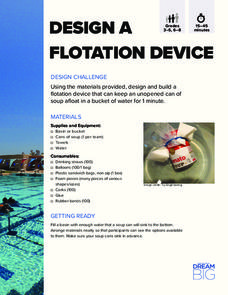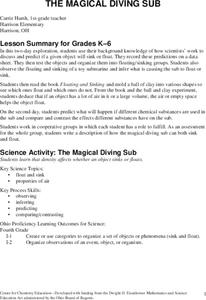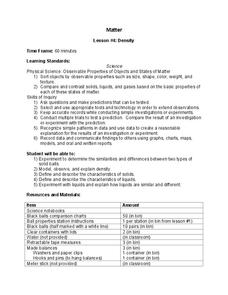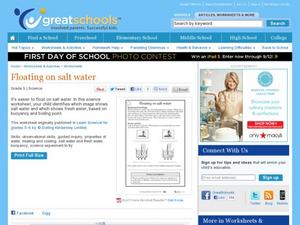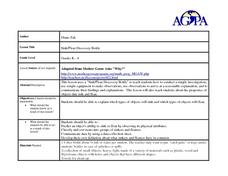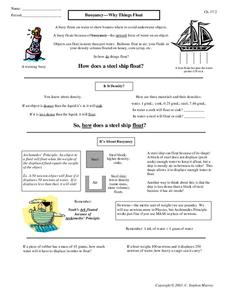Curated OER
Buoyancy and Viscosity
Some of these beautiful diagrams should help your students understand the connections between pressure and flight. Pressure and density are also discussed, and a number of links are included to give fantastic interactive examples of...
American Chemical Society
Float and Sink
We're not talking about the kitchen sink. Learners explore what types of objects sink and float in water in an inquiry-based instructional activity. With experimentation, they find similarities between materials that float and those that...
DiscoverE
Design a Flotation Device
Save the soup! Scholars devise a flotation device using straws, balloons, foam, corks, and other objects. A can of soup must stay afloat for at least a minute with this device—your dinner might depend on it!
DiscoverE
Action Figure Diver
Will your next buoyancy lab rise to the occasion? Make a splash with action figure divers! Teams of young physicists explore the relationship between mass and buoyancy by adding weights or balloons to achieve a diver that neither sinks...
University of Southern Indiana
Manifest Density
There's a lot content packed into the four lessons of this physical science unit on density. From salad dressing to the water cycle and hot air balloons, these lessons engage students in hands-on activities that explore real-world...
Curated OER
Break the Tension
Learners experiment with the concepts of surface tension. They participate in a number of different experiments that introduce them to surface tension. They work in a small group in order to conduct these experiments.
Curated OER
The Magical Diving Sub
First graders discuss and predict if a given object sinks or floats. They record their predictions on a data sheet. Pupils test the objects and organize them into floating/sinking groups. Students observe the floating and sinking of a...
Curated OER
Density
Learners predict when an object will float or sink based on comparison of density of the object to the density of the substance in which it is placed. The access a website and sketch the object in the first column of their table and then...
Curated OER
Water Resistance (1)
Get the class thinking about why particular objects and animals are shaped the way they are. Considering water resistance and shape, learners assess a series of images and how those objects function in water. They finish by conducting a...
Curated OER
Floating on Salt Water
Mixing substances together causes their properties to change. This resource illustrates that concept for fifth graders by having them consider four questions that have to do with buoyancy and boiling point. Learners begin to understand...
Curated OER
Made to Sail
Students use simple materials to make model sailboats which must stay upright and sail straight in a testing tank.
Curated OER
Lesson: Can-Do Canoe
Collaborative groups work together with a variety of materials to design an eight-inch canoe that floats for at least three minutes. There is no direct instruction involved in this plan, just a list of materials and a procedure for...
Curated OER
Sink It
Introduce your class to the concept of sinking and floating. In groups, they classify objects after making predictions about which materials will sink or float. They record their results and create graphs and charts to share with the class.
Curated OER
Will It Sink Or Float?
Have your class predict whether objects will sink or float in water. Learners consider a data table of mass, volume and whether the object sank or floated. They develop an evidence-based explanation for the results.
Curated OER
Sink/Float Discovery bottle
Investigate which items float and which ones sink using this resource. Learners participate in an activity in which they investigate this phenomena. Then they describe the experimental process, and learn how to display their results.
Curated OER
Types of Marine Debris
Students conduct an experiment. In this marine debris and environment protection lesson, students categorize trash into piles, predict whether these trash items will sink, float or be picked up and carried by the wind and then test...
Curated OER
Why Do Certain Things Float, While Some Sink?
First graders conduct an experiment. In this density lesson, 1st graders work in groups to test 10 different objects to see which ones sink and float. Students discuss why certain objects float and others do not.
Curated OER
Sink or Swim
Students explore sinking and floating. In this buoyancy lesson, students conduct an investigation dealing with regular and diet soda. Students drop various soda cans into water and then discuss why some float and some sink.
Curated OER
What's The Matter: A Sinker or Floater?
Young scholars conduct an experiment. In this water lesson, students watch the lesson "Float and Sink" on an interactive website. Young scholars learn how to test items in water and then work in groups to test their items. Students...
Curated OER
Dragon Boats
Students create a model boat. In this art lesson, students identify what makes a boat float and use milk cartons to create their own boat.
Curated OER
Buoyancy
In this buoyancy worksheet, students read about why objects float or sink. Students apply the Archimedes' Principle in a buoyancy lab. Students complete 1 graphic organizer.
Curated OER
Sink or Float?
Students will determine whether various objects sink or float in water. They do not need to explain why objects sink or float. They are rather to be encouraged to observe that the same objects will sink or float every time, i.e., that...
Curated OER
1st Grade - Act. 19: Will it Float?
First graders drop items into water, and discuss why some things float and others sink.
Curated OER
Sink or Float?
Learners make and test predictions about sinking and floating, and classify objects according to whether they sink or float.




